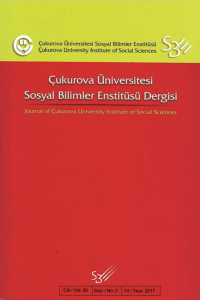Öz
Post Keynesyen İktisat Okulu ve dolayısıyla Post Keynesyen
iktisatçılar ekonomiyi bütüncül ve gerçekçi bir yapı içerisinde incelemeyi
amaçlamakta, neo-klasik iktisadın mantıksal zaman kavramından ziyade tarihsel
zaman kavramını kullanmaktadırlar. Bu doğrultuda gelir-istihdam ve enflasyon gibi
makroekonomik değişkenlerini reel dünyanın temel ekonomik göstergeleri olarak
dikkate almaktadırlar. Bu makalenin birincil amacı Ateşoğlu (2000) tarafından
ele alınan Gelir, İstihdam ve Enflasyon modellerinin açıklanmasıdır. İkincil
amaç ise, iki aşamalı sabit etkiler modelleri aracılığıyla 1995-2015 dönemi
için yirmi Avrupa Birliği üyesi ülkede gelir, istihdam ve enflasyon
modellerinin tahmin edilmesi ve modellerin geçerliliğinin sınanmasıdır. Elde
edilen ampirik sonuçlar, Post-Keynesyen talep yönlü makroekonomik modellerin
söz konusu Avrupa Birliği ülkelerinde geçerli olduğunu ortaya koymaktadır.
Anahtar Kelimeler
Post Keynesyen iktisat istihdam gelir otonom harcamalar sabit etkiler modeli
Kaynakça
- Asteriou, D. & Hall, S.G. (2011). Applied econometrics. London: Palgrave Macmillan. Atesoglu, S. (2000). Income, Employment, Inflation, and Money in the United States, Journal of Post Keynesian Economics, Vol. 22, No.4, 639-646 Baltagi, B. H., & Li, Q. (1991). A transformation that will circumvent the problem of autocorrelation in an error-component model. Journal of Econometrics, 48(3), 385-393. Baltagi, B.H. (2005). Econometric Analysis of Panel Data (3rd ed). England: John Wiley & Sons. Beck, N., & Katz, J. N. (1995). What to do (and not to do) with time-series cross-section data. American political science review, 89(03), 634-647. Greene, W. H. (2003). Econometric analysis. Pearson Education India. Kalecki, M. (1971). Class struggle and the distribution of national income. International Review of Social Sciences, 24(1), 1-9. Keynes, J. M. (1936). The General Theory of Employment, Interest and Money. V Harbinger Edition. Lavoie, M. (1992). Foundation of Post-Keynesian Economic Analysis. Edward Elgar Publishing Company. Lavoie, M. (2009). Introduction to Post-Keynesian Economics. New York: Palgrave Macmillian. Weintraub, S. (1981). Keynesian Demand Serendipity in Supply-Side Economics. Journal of Post Keynesian Economics, 4 (2), 181-191 Holt, R. (1997). Post Keynesian School of Economics. In T. Cate, Harcourt, G. & Colander, D.C. (eds.), An Encyclopedia of Keynesian Economics, Edward Elgar Publishing. Davidson P. (1994). Post Keynesian Macroeconomic Theory. England: Edward Elgar Publishing. Davidson, P. & Smolensky, E. (1964). Aggregate Supply and Demand Analysis. New York: Harper and Row, Publishers. Parks, R. W. (1967). Efficient estimation of a system of regression equations when disturbances are both serially and contemporaneously correlated. Journal of the American Statistical Association, 62(318), 500-509. https://data.oecd.org (Erişim tarihi: 01.03.2017) http://databank.worldbank.org/data/reports.aspx?source=world-development-indicators (Erişim tarihi: 01.03.2017)
Öz
Kaynakça
- Asteriou, D. & Hall, S.G. (2011). Applied econometrics. London: Palgrave Macmillan. Atesoglu, S. (2000). Income, Employment, Inflation, and Money in the United States, Journal of Post Keynesian Economics, Vol. 22, No.4, 639-646 Baltagi, B. H., & Li, Q. (1991). A transformation that will circumvent the problem of autocorrelation in an error-component model. Journal of Econometrics, 48(3), 385-393. Baltagi, B.H. (2005). Econometric Analysis of Panel Data (3rd ed). England: John Wiley & Sons. Beck, N., & Katz, J. N. (1995). What to do (and not to do) with time-series cross-section data. American political science review, 89(03), 634-647. Greene, W. H. (2003). Econometric analysis. Pearson Education India. Kalecki, M. (1971). Class struggle and the distribution of national income. International Review of Social Sciences, 24(1), 1-9. Keynes, J. M. (1936). The General Theory of Employment, Interest and Money. V Harbinger Edition. Lavoie, M. (1992). Foundation of Post-Keynesian Economic Analysis. Edward Elgar Publishing Company. Lavoie, M. (2009). Introduction to Post-Keynesian Economics. New York: Palgrave Macmillian. Weintraub, S. (1981). Keynesian Demand Serendipity in Supply-Side Economics. Journal of Post Keynesian Economics, 4 (2), 181-191 Holt, R. (1997). Post Keynesian School of Economics. In T. Cate, Harcourt, G. & Colander, D.C. (eds.), An Encyclopedia of Keynesian Economics, Edward Elgar Publishing. Davidson P. (1994). Post Keynesian Macroeconomic Theory. England: Edward Elgar Publishing. Davidson, P. & Smolensky, E. (1964). Aggregate Supply and Demand Analysis. New York: Harper and Row, Publishers. Parks, R. W. (1967). Efficient estimation of a system of regression equations when disturbances are both serially and contemporaneously correlated. Journal of the American Statistical Association, 62(318), 500-509. https://data.oecd.org (Erişim tarihi: 01.03.2017) http://databank.worldbank.org/data/reports.aspx?source=world-development-indicators (Erişim tarihi: 01.03.2017)
Ayrıntılar
| Bölüm | Makaleler |
|---|---|
| Yazarlar | |
| Yayımlanma Tarihi | 31 Ekim 2017 |
| Gönderilme Tarihi | 8 Kasım 2017 |
| Yayımlandığı Sayı | Yıl 2017 Cilt: 26 Sayı: 2 |


